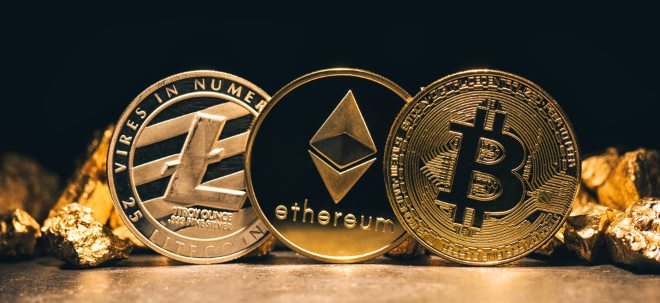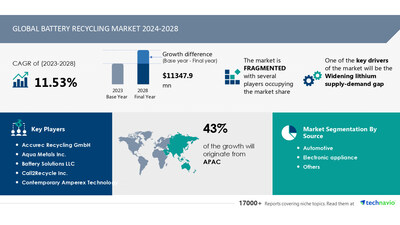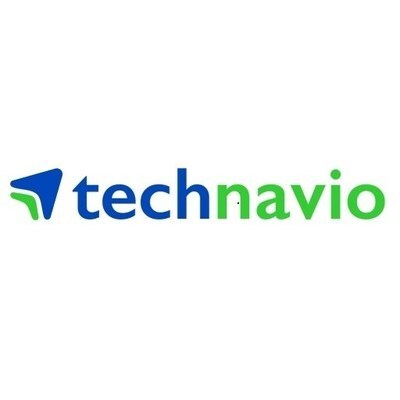Battery Recycling Market to grow by USD 11.35 Billion from 2024-2028, driven by lithium supply-demand gap, Report on AI's role in transforming the market - Technavio
NEW YORK, Nov. 27, 2024 /PRNewswire/ -- Report with market evolution powered by AI - The global battery recycling market size is estimated to grow by USD 11.35 billion from 2024-2028, according to Technavio. The market is estimated to grow at a CAGR of over 11.53% during the forecast period. Widening lithium supply-demand gap is driving market growth, with a trend towards rising stewardship collaboration for battery recycling. However, lead contamination in environment poses a challenge.Key market players include Accurec Recycling GmbH, Aqua Metals Inc., Battery Solutions LLC, Call2Recycle Inc., Contemporary Amperex Technology Co. Ltd., East Penn Manufacturing Co. Inc., Ecobat LLC, EnerSys, ENGITEC TECHNOLOGIES SPA, Exide Industries Ltd., Fortum Oyj, GEM Co. Ltd., Gopher Resource LLC, Gravita India Ltd., Li Cycle Holdings Corp., Onto Technology LLC, Raw Materials Co. Inc., SungEel Hi-Tech Co. Ltd., Terrapure Environmental, and Umicore SA.
AI-Powered Market Evolution Insights. Our comprehensive market report ready with the latest trends, growth opportunities, and strategic analysis- View Free Sample Report PDF
Forecast period | 2024-2028 |
Base Year | 2023 |
Historic Data | 2018 - 2022 |
Segment Covered | Source (Automotive, Electronic appliance, and Others), Battery Type (Lead-acid, Lithium, and Others), and Geography (APAC, Europe, North America, South America, and Middle East and Africa) |
Region Covered | APAC, Europe, North America, South America, and Middle East and Africa |
Key companies profiled | Accurec Recycling GmbH, Aqua Metals Inc., Battery Solutions LLC, Call2Recycle Inc., Contemporary Amperex Technology Co. Ltd., East Penn Manufacturing Co. Inc., Ecobat LLC, EnerSys, ENGITEC TECHNOLOGIES SPA, Exide Industries Ltd., Fortum Oyj, GEM Co. Ltd., Gopher Resource LLC, Gravita India Ltd., Li Cycle Holdings Corp., Onto Technology LLC, Raw Materials Co. Inc., SungEel Hi-Tech Co. Ltd., Terrapure Environmental, and Umicore SA |
Key Market Trends Fueling Growth
The battery recycling market is experiencing significant growth due to increasing trends in electric vehicles and renewable energy sectors. EPA guidelines are driving the need for safe and efficient battery recycling, particularly for lithium-ion batteries used in electric cars and PHEVs. Battery technologies, including lithium-ion, acid, sodium-sulfur, and hydride batteries, require innovative solutions to address energy density, charging capabilities, and maintenance requirements. Spent batteries contain hazardous materials like acids, heavy metals such as nickel, cobalt, lithium, and toxic substances like mercury and lead. Proper recycling prevents chemical leakage and toxic substance release, reducing environmental impact. Regulations are essential to ensure safe battery disposal and recycling. Renewable energy industries, such as solar and wind power, rely on battery storage systems like UPS systems, which also need recycling. Technological innovations in extrusion, nickel metal hydride, and lithium-iron phosphate batteries are crucial to improving yield and reducing logistics costs. Key players in the market include Element Resources, Umicore, and Redwood Materials. The automotive industry, particularly the demand for automobile batteries and lead-acid batteries, also contributes to the market growth. Industries must address the challenges of urbanization and electronic gadgets' battery waste disposal to minimize costs and ensure a sustainable supply chain.
The depletion of metal reserves and environmental concerns necessitate the recycling of batteries, with both primary and secondary batteries requiring attention. This responsibility should not solely rest with governments; instead, all stakeholders, including battery manufacturers, businesses, public agencies, and consumers, must collaborate. One such trend gaining traction is stewardship collaboration. Through this approach, all parties work together on a level playing field for end-of-life battery management. Manufacturers are expected to provide consumers with convenient and accessible ways, known as Extended Producer Responsibility (EPR) programs, to return used batteries.
Insights on how AI is driving innovation, efficiency, and market growth- Request Sample!
Market Challenges
- The battery recycling market faces several challenges in the context of evolving battery technologies and increasing demand for energy storage in various sectors. EPA guidelines require strict regulations for handling spent batteries containing hazardous materials like acids, heavy metals, mercury, lead, and toxic substances. The rise of electric vehicles and renewable energy sectors, particularly solar and wind power, increases the generation of spent batteries, especially lithium-ion, acid, and sodium-sulfur types. The scarcity of technologies and high costs for recycling these batteries pose a significant challenge. Nickel, cobalt, lithium, and other essential minerals are in high demand for battery production, making battery waste disposal a critical issue. Regulations and infrastructure development are essential to mitigate these challenges. Companies like Element Resources, Umicore, Redwood Materials, LOHUM Cleantech, BEEAH, ACE Green Recycling, and Criba are leading the way in battery recycling, focusing on technological innovations and improving yield. However, logistics costs, emissions, and the complexity of battery chemistries, plastics, and extrusion processes remain obstacles. The energy storage market's growth depends on addressing these challenges and ensuring a sustainable supply chain.
- The lead-acid battery chemistry is currently the most profitable in the battery recycling market. However, the toxic nature of lead poses environmental concerns. Improper disposal of lead-acid batteries can lead to significant pollution of soil and water. A single battery incorrectly disposed of in a municipal solid waste (MSW) collection system can contaminate up to 25 tons of waste. Therefore, it's crucial to collect and recycle these batteries in an eco-friendly manner as soon as they become inoperative. Ensuring proper disposal and recycling not only reduces environmental harm but also maximizes the potential revenue from these batteries.
Insights into how AI is reshaping industries and driving growth- Download a Sample Report
Segment Overview
This battery recycling market report extensively covers market segmentation by
- 1.1 Automotive
- 1.2 Electronic appliance
- 1.3 Others
- 2.1 Lead-acid
- 2.2 Lithium
- 2.3 Others
- 3.1 APAC
- 3.2 Europe
- 3.3 North America
- 3.4 South America
- 3.5 Middle East and Africa
1.1 Automotive- The automotive segment of the battery recycling market is driven by the increasing demand for automobiles, particularly in emerging economies. Lead-acid batteries, which are the primary type used in the automotive industry for starting, lighting, and ignition (SLI) in internal combustion engine (ICE) vehicles and start-stop applications in conventional and electric vehicles, are in high demand. The growing popularity of electric vehicles (EVs) and e-bikes, fueled by environmental concerns and government initiatives, is further boosting the market. In the automotive industry, batteries provide electric energy to vehicles, enabling the starting of motors, lighting, and ignition systems. Passenger vehicles typically use one battery, while heavy-duty vehicles require two batteries to complete a 24-volt system. The expanding automobile industry, driven by economic growth, industrialization, and rising consumer confidence, is expected to increase the demand for battery recycling during the forecast period. Additionally, the growing adoption of e-bikes in Asian countries and the increasing demand for EVs in Europe and other regions are expected to significantly contribute to the growth of the automotive battery recycling market.
Download complimentary Sample Report to gain insights into AI's impact on market dynamics, emerging trends, and future opportunities- including forecast (2024-2028) and historic data (2018 - 2022)
Research Analysis
The Battery Recycling Market is witnessing significant growth due to increasing environmental concerns and the need for sustainable energy solutions. EPA guidelines mandate proper disposal of spent batteries, which contain hazardous materials such as acids, heavy metals like nickel, manganese, mercury, and lead. These batteries, used in electric vehicles, UPS systems, and other applications, have high energy density and charging capabilities, but require minimal maintenance. Battery recycling is crucial to mitigate chemical leakage and toxic substance release. Li-ion batteries, a key technology, pose unique challenges due to their chemistry and plastics composition. Extraction processes like nickel metal hydride and manganese-nickel oxide hydroxide are commonly used. Redwood Materials and other companies are innovating to improve yield and reduce costs in the battery waste disposal supply chain. Technological innovations, such as advanced pyrometallurgical and hydrometallurgical processes, are also driving market growth.
Market Research Overview
The battery recycling market is experiencing significant growth due to the increasing demand for electric vehicles (EVs) and the expansion of renewable energy sectors such as solar and wind power. Battery technologies, including lithium-ion, acid, sodium-sulfur, and hydride batteries, are in high demand for energy storage solutions. However, spent batteries pose challenges due to hazardous materials like acids, heavy metals, mercury, lead, and toxic substances. EPA guidelines aim to mitigate environmental risks by regulating battery disposal. The federal government is investing in research and development to address the dearth of technologies for recycling essential minerals like nickel, cobalt, lithium, and manganese. Battery recycling is crucial for reducing logistics costs, emissions, and the demand for new batteries. Companies are exploring technological innovations to improve yield and minimize chemical leakage. Renewable energy industries, including solar, wind, UPS systems, and electric cars, are major consumers of batteries, driving the market forward. Battery recycling is essential for the circular economy, particularly in industries undergoing industrialization and urbanization, such as automotive and electronic gadgets. Companies like Redwood Materials, LOHUM Cleantech, Criba, BEEAH, ACE Green Recycling, and others are leading the way in battery recycling, extracting valuable materials from battery waste through processes like extrusion and nickel metal hydride technology. However, challenges remain, including the complexity of battery chemistries and the need for supply chain to ensure the efficient collection and processing of batteries. The costs of battery recycling must be competitive with primary production to make it a viable and sustainable solution. The future of battery recycling lies in technological innovations that can improve yield, reduce costs, and minimize environmental impact.
Table of Contents:
1 Executive Summary
2 Market Landscape
3 Market Sizing
4 Historic Market Size
5 Five Forces Analysis
6 Market Segmentation
- Source
- Automotive
- Electronic Appliance
- Others
- Battery Type
- Lead-acid
- Lithium
- Others
- Geography
- APAC
- Europe
- North America
- South America
- Middle East And Africa
7 Customer Landscape
8 Geographic Landscape
9 Drivers, Challenges, and Trends
10 Company Landscape
11 Company Analysis
12 Appendix
About Technavio
Technavio is a leading global technology research and advisory company. Their research and analysis focuses on emerging market trends and provides actionable insights to help businesses identify market opportunities and develop effective strategies to optimize their market positions.
With over 500 specialized analysts, Technavio's report library consists of more than 17,000 reports and counting, covering 800 technologies, spanning across 50 countries. Their client base consists of enterprises of all sizes, including more than 100 Fortune 500 companies. This growing client base relies on Technavio's comprehensive coverage, extensive research, and actionable market insights to identify opportunities in existing and potential markets and assess their competitive positions within changing market scenarios.
Contacts
Technavio Research
Jesse Maida
Media & Marketing Executive
US: +1 844 364 1100
UK: +44 203 893 3200
Email: media@technavio.com
Website: www.technavio.com/
![]() View original content to download multimedia:https://www.prnewswire.com/news-releases/battery-recycling-market-to-grow-by-usd-11-35-billion-from-2024-2028--driven-by-lithium-supply-demand-gap-report-on-ais-role-in-transforming-the-market---technavio-302316588.html
View original content to download multimedia:https://www.prnewswire.com/news-releases/battery-recycling-market-to-grow-by-usd-11-35-billion-from-2024-2028--driven-by-lithium-supply-demand-gap-report-on-ais-role-in-transforming-the-market---technavio-302316588.html
SOURCE Technavio



